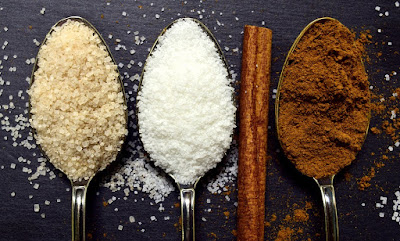Added Sugar vs Natural Sugar: When to Eat it and When to Avoid It
What is sugar anyway? Sugar is a type of simple carbohydrate that is broken down and absorbed in your body to be used as energy. Carbohydrates (which are your sugars and starches), are broken down to form glucose, which is the type of sugar your body uses for energy – which means carbohydrates, and sugars, are very important in your diet!
So what is the difference between natural sugar and added sugar? Natural sugars are found in milk and fruit and are not considered added sugars. On the other hand, added sugars are any sugar or syrup that is added during processing or preparation of foods or beverages. But why does it matter?
 |
Foods such as ice cream, candy, cakes, pastries, and sugary cereals, all contain added sugars without giving you any other nutritional benefits, such as vitamins or minerals – while also providing you with a significant amount of excess calories. It is recommended that 10% or less of your calories come from added sugars. Based on a 2,000 calorie diet, this about 200 calories, or 50 grams of added sugar (12.5 teaspoons.)
You may already see added sugars listed on nutrition labels, and by January 2020 it will become mandatory for food companies to include the added sugars on the labels. This will make it easier to determine where the sugars are coming from. Before this regulation, it was hard to identify added sugars in products because of the various names for added sugars found in the ingredients list like brown sugar, corn sweetener, high fructose corn syrup, honey, and fructose.
 |
| Different names for added sugars commonly found in the ingredients list on the nutrition label. |
For one serving of a particular brand of ice cream shown below, there are 31 grams of sugar. According to the food label, 23 grams of the 31 grams are from added sugars. So where do the other 8 grams of sugar come from? They are naturally occurring sugars found in milk and cream. By reading the updated nutrition label and by looking at the ingredients, it becomes easier to identify where the sugars are coming from.
It is important to remember that it is okay to eat foods with added sugars in moderation. Sometimes it’s good to include them in your diet because it improves the taste of healthy foods that contain vitamins and minerals, like flavored yogurts and fortified whole grain cereals.
One serving of this product also includes Vitamin D, Calcium, Iron, and Potassium, which are important vitamins, minerals, and electrolytes that you need in your diet every day. Consuming this nutrient dense product that also contains added sugars is better than avoiding the product and added sugar and not getting the benefits of the nutrients at all.
So should you avoid eating sugar all together? No. Both natural and added sugar can be part of a healthy diet as long as you eat it in moderation. It is important to read the nutrition label to find the source of the sugar and to determine the nutritional quality of the product in its entirety. Focusing on only one part, such as total fat or total sugars, can give you a false sense of the nutritional quality of the product, or prevent you from seeing the true nutritional benefits of the product.
A product that contains no added sugar may be very high in fat. Conversely, a product that does contain added sugar may be loaded with vitamins and minerals. Ruling out a product based on one nutritional attribute may not be beneficial to you or your health. So be sure to check the nutrition labels next time you're browsing the aisles of the grocery store to determine the amount of added sugar and nutrients in the foods you eat!
The U.S. Food and Drug Administration (2018a). Changes to the nutrition facts label. Retrieved from https://www.fda.gov/food/guidanceregulation/guidancedocumentsregul atoryinformation/labelingnutrition/ucm385663.htm
- E.L.
Duyff, R. L. (2017).The Complete Food and Nutrition Guide (5th ed.). New York, NY: Mifflin Harcourt Publishing Company.
The U.S. Department of Health and Human Services & The U.S. Department of Agriculture. (2015). 2015 – 2020 Dietary Guidelines for Americans. 8th Edition. December 2015.The U.S. Food and Drug Administration (2018a). Changes to the nutrition facts label. Retrieved from https://www.fda.gov/food/guidanceregulation/guidancedocumentsregul atoryinformation/labelingnutrition/ucm385663.htm



Great post. Added sugar is definitely a problem in our society, but I think that it is sometimes demonized to the point that people don't look at what some foods may have to offer outside of this added sugar. I really appreciate you laying out that some foods, while containing added sugar, can still provide nutritional benefits.
ReplyDelete-CB